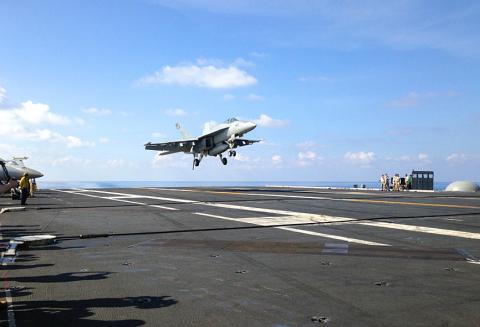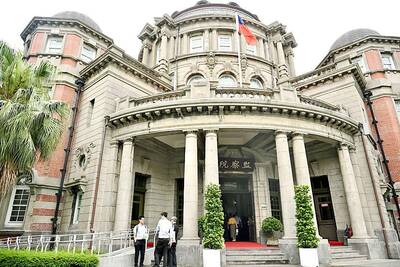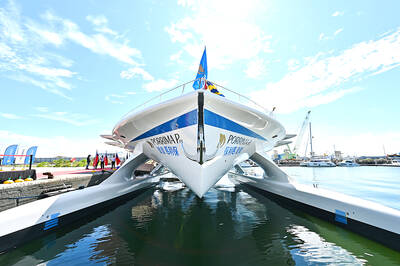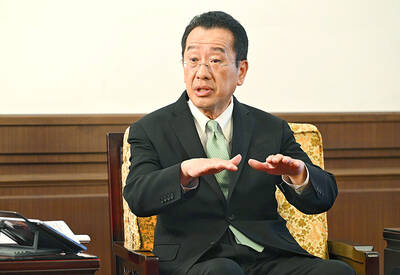For the second time in five months, US Secretary of Defense Ashton Carter landed aboard a US aircraft carrier in the bitterly contested South China Sea, sending a deliberate message to China on US power in the region.
With a key Asia Pacific ally at his side, Carter’s visit aboard the USS John C. Stennis underscores persistent complaints from the US and its allies in the region about China’s military buildup in the South China Sea.
Beijing has been creating artificial islands, and equipping many with runways, fighter aircraft and other weapons.

Photo: AP
Carter stood alongside Philippine Secretary of Defense Voltaire Gazmin as they watched US Navy fighter jets launch into the vivid blue skies, about 130km west of the island of Luzon.
Later in the massive gray ship’s hangar bay, Carter said his message in making the trip is that the US “intends to continue to play a role in keeping peace and stability in this region.”
He said the only reason the US’ presence in the region comes up as an issue is because of China’s behavior over the past year — and “that’s a question of Chinese behavior.”
“What’s new is not an American carrier in this region. What’s new is the context of tension which exists, which we want to reduce,” he said.
Carter spent about two hours on the ship, watching a number of fighters shoot into the sky off the flight deck, do circles around the Stennis and then land again, roaring to a stop as their tailhooks caught the arresting wire.
He later spoke to several hundred sailors in the hangar bay, including one who asked why the US allows China to participate in the large annual military exercise in the Asia Pacific.
He said the US wants to work with China, adding that Beijing should not isolate itself.
The Chinese Ministry of Foreign Affairs on Thursday issued a statement criticizing increased US military support for the Philippines, saying: “Military exchanges by relevant countries should not target third parties, much less support a few countries in challenging China’s sovereignty and security, inciting regional contradictions and sabotaging regional peace and stability.”
Beijing continued its rhetoric yesterday, with ministry spokesman Lu Kang (陸慷) saying: “Before the US returned to the Asia Pacific region, relevant countries had sought to control the disputes and handle the conflicts through friendly negotiations, despite the disputes having existed for over four decades.”
He told reporters during a press conference that if the US wants a peaceful solution to disputes, “I hope it can practice what it has preached, and that their actions can really help to peacefully solve the disputes.”
The Philippines is one of several countries, including Taiwan, that have overlapping claims with China.
The US has said it does not take a position on the claims, but wants them settled legally.

GAINING STEAM: The scheme initially failed to gather much attention, with only 188 cards issued in its first year, but gained popularity amid the COVID-19 pandemic Applications for the Employment Gold Card have increased in the past few years, with the card having been issued to a total of 13,191 people from 101 countries since its introduction in 2018, the National Development Council (NDC) said yesterday. Those who have received the card have included celebrities, such as former NBA star Dwight Howard and Australian-South Korean cheerleader Dahye Lee, the NDC said. The four-in-one Employment Gold Card combines a work permit, resident visa, Alien Resident Certificate (ARC) and re-entry permit. It was first introduced in February 2018 through the Act Governing Recruitment and Employment of Foreign Professionals (外國專業人才延攬及雇用法),

WARNING: From Jan. 1 last year to the end of last month, 89 Taiwanese have gone missing or been detained in China, the MAC said, urging people to carefully consider travel to China Lax enforcement had made virtually moot regulations banning civil servants from making unauthorized visits to China, the Control Yuan said yesterday. Several agencies allowed personnel to travel to China after they submitted explanations for the trip written using artificial intelligence or provided no reason at all, the Control Yuan said in a statement, following an investigation headed by Control Yuan member Lin Wen-cheng (林文程). The probe identified 318 civil servants who traveled to China without permission in the past 10 years, but the true number could be close to 1,000, the Control Yuan said. The public employees investigated were not engaged in national

The zero emissions ship Porrima P111 was launched yesterday in Kaohsiung, showcasing the nation’s advancement in green technology, city Mayor Chen Chi-mai (陳其邁) said. The nation last year acquired the Swiss-owned vessel, formerly known as Turanor PlanetSolar, in a bid to boost Taiwan’s technology sector, as well as ecotourism in Palau, Chen said at the ship’s launch ceremony at Singda Harbor. Palauan President Surangel Whipps Jr and Minister of Foreign Affairs Lin Chia-lung (林佳龍) also attended the event. The original vessel was the first solar-powered ship to circumnavigate the globe in a voyage from 2010 to 2012. Taiwan-based Porrima Inc (保利馬) installed upgrades with

ENHANCE DETERRENCE: Taiwan has to display ‘fierce resolve’ to defend itself for China to understand that the costs of war outweigh potential gains, Koo said Taiwan’s armed forces must reach a high level of combat readiness by 2027 to effectively deter a potential Chinese invasion, Minister of National Defense Wellington Koo (顧立雄) said in an interview with the Chinese-language Liberty Times (sister newspaper of the Taipei Times) published yesterday. His comments came three days after US Secretary of State Marco Rubio told the US Senate that deterring a Chinese attack on Taiwan requires making a conflict “cost more than what it’s worth.” Rubio made the remarks in response to a question about US policy on Taiwan’s defense from Republican Senator John Cornyn, who said that Chinese